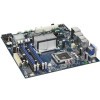- Qualcomm Launches Snapdragon 4 Gen 2 Mobile Platform
- AMD Launches Ryzen PRO 7000 Series Mobile & Desktop Platform
- Intel Launches Sleek Single-Slot Arc Pro A60 Workstation Graphics Card
- NVIDIA Announces Latest Ada Lovelace Additions: GeForce RTX 4060 Ti & RTX 4060
- Maxon Redshift With AMD Radeon GPU Rendering Support Now Available
Intel Desktop Board DG45ID

We’re taking a look at Intel’s first attempt at a full-featured media center motherboard, the DG45ID. It’s also our first look at their new G45 Express chipset, which promises to finally bring DX 10 support and hardware-accelerated HD video playback to their integrated graphics offerings. Can the DG45ID prove itself a worthy choice for your HTPC?
Page 8 – Hardware: HD Tach RW3, Sandra 2008 Memory Tests
Thus far, we’ve seen that in multimedia application testing that doesn’t involve hardware video acceleration, the Intel DG45ID motherboard falls a few steps behind its last-generation competition. Direct benchmark testing of the storage and memory subsystems will likely reveal the reason for the DG45ID’s underwhelming performance.
Simpli Software HD Tach RW3
To test the storage subsystem, we rely on Simpli Software’s HD Tach, a superb storage benchmarking tool that’s now free for everyone to use. It excels at benchmarking a variety of internal and external storage devices, and produces consistent data and information-rich reports.
For this review, HD Tach will be used to test the internal hard drive’s data transfer rates. Since the main system drive is being tested, which contains the operating system software, we will only be performing read tests, not write tests (which might cause data corruption.) Also, since we’re not specifically interested in the drive’s performance per se, we won’t be running any access time testing.

What’s plainly clear is that the Intel DG45ID’s ICH10 storage controller just can’t manage to outpace the ASUS board’s last-generation ICH9 storage controller – suggesting that all that’s changed between the two southbridge chips is the ICH10’s smaller 65nm manufacturing process.
SiSoftware Sandra 2008.SP2
SiSoft’s venerable Sandra benchmarking suite is our tool of choice for assessing the performance of memory subsystems accurately and consistently. We’ll be using it here to test memory bandwidth and latency.


As you can see here, the DG45ID also suffers from slower memory performance than its third-party competitor – though the memory controller aboard the G45 GMCH northbridge is exactly the same as that on the G35 chipset’s northbridge. This can only be blamed on a lack of performance tuning; the DG45ID simply hasn’t been tweaked to wring the maximum possible performance out of the G45 chipset.
Next, let’s see if the G45 chipset’s improved GMA X4500HD graphics core can give it the upper hand in our gaming tests.
Support our efforts! With ad revenue at an all-time low for written websites, we're relying more than ever on reader support to help us continue putting so much effort into this type of content. You can support us by becoming a Patron, or by using our Amazon shopping affiliate links listed through our articles. Thanks for your support!




